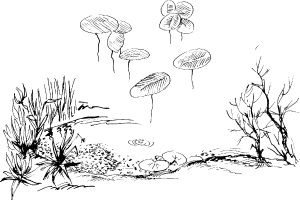Common Aquatic Plant Management Problems
Please note:
This information is intended for educational purposes only. References to commercial
products or trade names are made with the understanding that no discrimination is intended of
other products which may be available. Any herbicides recommended herein for the treatment
of aquatic vegetation have been registered by the Environmental Protection Agency for use
in the manner described. The registration and use of a particular product may change
therefore the information provided here may not remain current indefinitely. It is the
responsibility of the user to read and follow the manufacturer's label to prevent misuse
of the product.
Common Duckweed
Scientific Name - Lemna minor
Common Name - Duckweed

Distribution and Habitat
Duckweed is found statewide but most commonly in the piedmont, midlands and coastal plain. It thrives in quiescent ponds and backwaters where little water movement is present. The rapid rate at which duckweed can reproduce may result in total coverage of the pond's surface in a short period of time. It is often associated with ponds having high levels of organic nutrients such as those found in livestock or swine feed lots or waste treatment facilities.
Description
Duckweed is a very small floating aquatic plant, usually light green in color. The individual leaf or frond of duckweed is oval or elliptic in shape, 1/10 to 1/8 inch long and less than 1/10 inch wide. These may be solitary or in groups of 2-4. Each frond has a small hair-like rootlet extending beneath it 1/8 to 1/4 inch in length. This small plant is sometimes mistaken for algae.
Recommended Control Methods
1. Diquat Dibromide
Active Ingredients: Diquat dibromide salts
Product Name: Reward/Weedtrine D/Aqua-Clear
Approximate Cost: $90.00 - $100.00/gal.
Application Rates: 1-2 gal./surface acre
Application Methods and Tips:
Early detection and treatment will result in more successful control of duckweed. Dibromide must be applied as a spray application to duckweed. The herbicide should be mixed with enough water to ensure even coverage of the treatment area. Higher rates will be required in situations of dense growth. A non-ionic surfactant such as Ortho 77, Induce, Passage, Quickwet, etc. should be incorporated with the herbicide at a rate of ½-2 pts. per 50 gals. of mixture. Care should be taken not to disturb the duckweed after the spray has been applied. It is often difficult to effectively target all the plants with a single treatment, therefore follow-up applications may be necessary at 14 day intervals. This herbicide should not be applied in muddy water as it will be inactivated. Certain water use restrictions apply to the use of this herbicide. Additional product directions and precautionary statements are listed on the herbicide container. READ AND FOLLOW THE HERBICIDE LABEL.2. Sonar AS
Active Ingredients: Fluridone
Product Names: Sonar As
Approximate Cost: $275.00 - $300.00/qt.
Application Rates: .50 - 1.25 qts/surface acre
Application Methods and Control Tips:
Sonar AS is labeled for the control of duckweed when applied as a surface spray. Plants may not show evidence of herbicidal exposure for four to twelve weeks after treatment. This product should not be applied to ponds with short retention times (high volume turnover). Sonar AS should be mixed with enough water to ensure uniform coverage of the area to be sprayed. Additional directions and precautionary statements are listed on the herbicide container. READ AND FOLLOW THE HERBICIDE LABEL.
Consult the fisheries biologist serving your county or more details concerning use of these products.
3. Sterile Grass Carp (White Amur)
Grass carp are generally considered to be marginally effective in controlling duckweed in most situations. These fish will provide acceptable control when stocked in high densities (more than 25 fish/acre) where duckweed infestation is moderate to low.
The above information is available as a downloadable PDF - Duckweed
